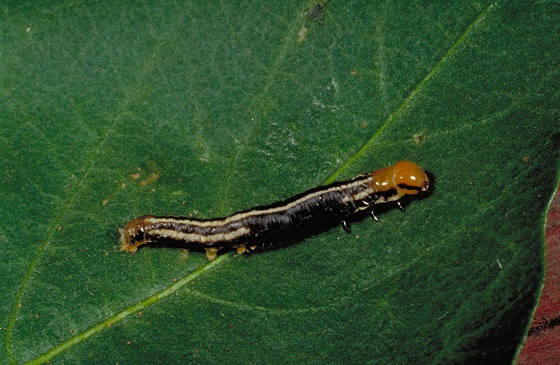The Common Stalk Borer in Corn
ENTFACT-100: The Common Stalk Borer in Corn | Download PDF
by Ric Bessin, Extension Entomologist
University of Kentucky College of Agriculture
Symptoms of Infestation
Damage to corn caused by common stalk borer is characterized by wilting and/or dying of the upper leaves or by ragged irregular holes chewed in the newly unrolled leaves. The "dead heart" is caused by the insect boring into the stalk at the soil level and tunneling upward. It may also climb up plants and tunnel downward into whorls, creating the ragged holes. A considerable amount of "frass", or sawdust-like borer feces, can be seen in the whorl or coming out of the borer's entry hole in the stalk. Corn plants from 2 to 24 inches tall may be attacked. In conventional corn, damage is usually confined to weedy border rows along fences, grass waterways and contour strips, while weedy no-till fields may have damage throughout.
Plants damaged by stalk borers are often stunted and/or misshapen and may die. Infested plants (if they survive) may or may not produce harvestable ears. If they do, ears are usually smaller than normal. Those plants that do not produce ears compete with productive plants for water, nutrients and sunlight.
Figure 1. Common stalk borer is recognized by stripes that are interrupted on the side of the body behind the thorax.
Pest Identification
Unrolling the whorl or damaged plants will usually reveal the borer. Small larvae are cream colored with a dark brown or purple band around the body. Several dark lengthwise stripes may be present. Full-grown larvae may lack the dark stripes and band, making them harder to identify. Common stalk borer larvae are usually very active when handled.
Biology
Common stalk borer is native to North America and attacks 176 different plant species. An increase in no-till corn acreage has increased common stalk borer incidence and problems.
Adult moths are grayish brown in color with small white spots along the front edge and along the tips of the forewings. The hind wings are a pale gray-brown. Wingspan is about one inch. The female moths lay their eggs in late summer and fall.
Preferred egg-laying sites are on weedy hosts. The stalk borer overwinters in the egg stage. Eggs begin hatching in late April and early May and the tiny borers immediately burrow into grasses or other weeds. When these grasses die, or the borers become too big, they emerge at night and tunnel into new hosts, including corn. This movement of borers will also occur if the grasses are cut or killed by herbicides. Borers will crawl to the first plant that is large enough for them to enter. Common stalk borers sometime remain in grass stems in no-till fields where the herbicide was not effective. Common stalk borers will leave the plant and drop to the ground where they dig a cell and pupate.
Sometimes they pupate in corn stalks or other plants with large stems. Pupation occurs beginning in late July. Adult moths then begin flying early in August, with emergence continuing until October.
Control and Management
Currently, no effective rescue insecticide treatment is available to control stalk borers once they have entered the plants. In-furrow applications of systemic insecticides at planting have not been effective in controlling stalk borers. Spraying weeds with a herbicide/insecticide combination has also not been effective. These last two failures are probably due to the fact that borers emerge from grasses over a period of several weeks, while insecticides lose their effectiveness the longer they are exposed to the elements.
Spraying grasses with a "burn down" herbicide and a residual insecticide before planting forces borers to move quickly over a shorter period of time, exposing them to a higher concentration of insecticide. This technique can be used in no-till fields that have had a history of common stalk borer problems.
The degree of common stalk borer infestations in no-till corn is directly linked to the amount of grass present the year before. Therefore, stalk borer management in no-till corn should begin with good weed management. Killing grasses and weeds along field margins before the adult moths begin their egg laying in the late summer or fall helps to reduce incidence the following year. Mowing, burning or using herbicides are all effective. However, these practices should not be done when borers are active (between planting and early July), as this will only cause them to move into nearby crops. Another word of caution on this tactic is that grasshoppers may be driven into nearby crops as well.
Incidence in Kentucky
Common stalk borer has been a sporadic pest of corn in Kentucky. According to IPM scouting observations, the insect was found in less than 5% of the fields that were scouted. The stalk borer has appeared as early as May 31, but normally is not observed until mid-June.
CAUTION! Pesticide recommendations in this publication are registered for use in Kentucky, USA ONLY! The use of some products may not be legal in your state or country. Please check with your local county agent or regulatory official before using any pesticide mentioned in this publication.
Revised: 11/19
Of course, ALWAYS READ AND FOLLOW LABEL DIRECTIONS FOR SAFE USE OF ANY PESTICIDE!
Photos courtesy Ric Bessin, University of Kentucky Entomology

